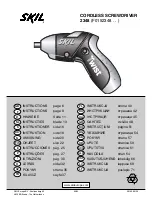
9
NOTE:
• Depending on the conditions of use and the ambient
temperature, the indication may differ slightly from the
actual capacity.
• The first (far left) indicator lamp will blink when the
battery protection system works.
Tool/battery protection system
The tool is equipped with a tool/battery protection
system.
This system automatically cuts off power to the motor to
extend tool and battery life.
The tool will automatically stop during operation if the
tool or battery are placed under one of the following
conditions. In some conditions, the indicators light up.
Overload protection
When the tool is operated in a manner that causes it to
draw an abnormally high current, the tool automatically
stops without any indication. In this situation, turn the tool
off and stop the application that caused the tool to
become overloaded. Then turn the tool on to restart.
Overheat protection for battery
When the battery is overheated, the tool stops
automatically without any indication. The tool does not
start even if pulling the switch trigger. In this situation, let
the battery cool before turning the tool on again.
Overdischarge protection (Fig. 3)
When the remaining battery capacity gets low, the
battery indicator blinks on the applicable battery side. By
further use, the tool stops and the battery indicator lights
up about 10 seconds. In this situation, charge the battery
cartridge.
Switch action (Fig. 4)
CAUTION:
• Before inserting the battery cartridge into the tool,
always check to see that the switch trigger actuates
properly and returns to the “OFF” position when
released.
To start the tool, simply pull the switch trigger. Tool speed
is increased by increasing pressure on the switch trigger.
Release the switch trigger to stop.
Lighting up the lamp (Fig. 5)
CAUTION:
• Do not look in the light or see the source of light
directly.
Pull the switch trigger to light up the lamp. The lamp
keeps on lighting while the switch trigger is being pulled.
The light automatically goes out 10 – 15 seconds after
the switch trigger is released.
NOTE:
• Use a dry cloth to wipe the dirt off the lens of the lamp.
Be careful not to scratch the lens of lamp, or it may
lower the illumination.
• Do not use thinner or gasoline to clean the lamp. Such
solvents may damage it.
Reversing switch action (Fig. 6)
This tool has a reversing switch to change the direction
of rotation. Depress the reversing switch lever from the A
side for clockwise rotation or from the B side for
counterclockwise rotation.
When the reversing switch lever is in the neutral position,
the switch trigger cannot be pulled.
CAUTION:
• Always check the direction of rotation before operation.
• Use the reversing switch only after the tool comes to a
complete stop. Changing the direction of rotation
before the tool stops may damage the tool.
• When not operating the tool, always set the reversing
switch lever to the neutral position.
Changing the quick change chuck for SDS-plus
For Model DHR264
The quick change chuck for SDS-plus can be easily
exchanged for the quick change drill chuck.
Removing the quick change chuck for SDS-plus
(Fig. 7)
CAUTION:
• Before removing the quick change chuck for SDS-plus,
always remove the bit.
Grasp the change cover of the quick change chuck for
SDS-plus and turn in the direction of the arrow until the
change cover line moves from the
symbol to the
symbol. Pull forcefully in the direction of the arrow.
Attaching the quick change drill chuck (Fig. 8)
Check the line of the quick change drill chuck shows the
symbol. Grasp the change cover of the quick change
drill chuck and set the line to the
symbol.
Place the quick change drill chuck on the spindle of the
tool.
Grasp the change cover of the quick change drill chuck
and turn the change cover line to the
symbol until a
click can clearly be heard.
Selecting the action mode
Rotation with hammering (Fig. 9)
For drilling in concrete, masonry, etc., depress the lock
button and rotate the action mode changing knob to the
symbol. Use a tungsten-carbide tipped bit.
Rotation only (Fig. 10)
For drilling in wood, metal or plastic materials, depress
the lock button and rotate the action mode changing
knob to the
m
symbol. Use a twist drill bit or wood bit.
Hammering only (Fig. 11)
For chipping, scaling or demolition operations, depress
the lock button and rotate the action mode changing
knob to the
symbol. Use a bull point, cold chisel,
scaling chisel, etc.
CAUTION:
• Do not rotate the action mode changing knob when the
tool is running. The tool will be damaged.
• To avoid rapid wear on the mode change mechanism,
be sure that the action mode changing knob is always
positively located in one of the three action mode
positions.
Torque limiter
The torque limiter will actuate when a certain torque level
is reached. The motor will disengage from the output
shaft. When this happens, the bit will stop turning.
CAUTION:
• As soon as the torque limiter actuates, switch off the
tool immediately. This will help prevent premature wear
of the tool.
• Hole saws cannot be used with this tool. They tend to
pinch or catch easily in the hole. This will cause the
torque limiter to actuate too frequently.
Содержание DHR263
Страница 5: ...5 25 26 27 014418 001145 014412 35 36 14 37 38 39 ...
Страница 83: ...83 ...










































